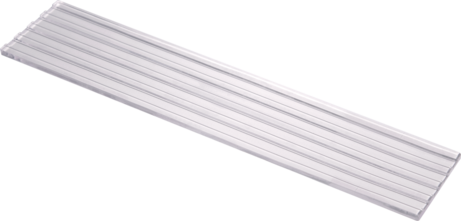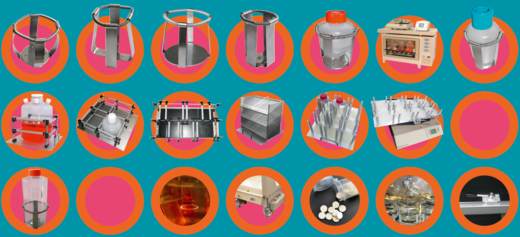to view content for your location.



Sticky strips offer a popular alternative to clamps and other holders. Containers are placed directly on the sticky strips and can be shaken at speeds up to 200rpm.
Order number | Description |
|---|---|
105194 |
1 sticky strip (clear) |
105196 | 1 sticky strip (clear) |
105226 | Set of sticky strips for E-size tray (clear) |
105227 | Set of sticky strips for EX-size tray (clear) |
105228 |
Set of sticky strips for F-size tray (clear)
|
106496 |
Sticky strip for EPFL (clear)
|
Sticky mats/strips are used to fix shake flasks or other equipment on shakings trays. They provide easy handling and flexible positioning of several sizes and forms of flasks.
Maximum shaking frequencies
in case flat bottom flasks (filled up to 20% nominal volume) are placed on the
sticky strips/mats
| Shaking diameter | Maximum applicable shaking frequency |
|---|---|
| 50 mm | 200 rpm |
| 25 mm | 250 rpm |
| 12.5 mm | 300 rpm |
For higher shaking frequencies, we recommend the use of clamps. Several sizes and forms of clamps for all types of shake flasks are available at Adolf Kühner AG. Please contact Adolf Kühner AG in case you need support concerning the usage of the sticky mats and other accessories.
If it is unsure if the sticky strips/mats can be used for your application, a functionality test must be performed with a sample flask and desired shaking parameters to determine if the sticky strips/mats are suitable for this type of application.
When starting the shaking operation, observe the setup until the desired
shaking frequency is reached. The smaller the shaking diameter of the shaker is
adjusted, the higher the shaking frequency can be set (see table above). In
case shake flasks with baffles are used, the shaking frequency must be reduced.
For close contact to the sticky mat, press the shake flask slightly downwards
after positioning.
The sticky mats/strips are suitable for a working temperature range of 5 to 80°C.
To remove shake flasks from the sticky strips, gently pull at the neck of the shake flask while tilting the flask slightly. Do not pull the flasks directly upwards, this way the shake flask can hardly be removed, and medium may splash onto the inside of the shake flask lid.
Sticky strips have a flat side and a grooved side.
The flat side of the sticky mats/strips is suitable for all shake flasks less than 3 L flask size and / or for shake flasks with a bottom area up to 30 cm2. If you intend to shake a diverse range of objects, this side is recommended.
The grooved side of the sticky mats/strips is suitable for flask with a
filling volume of 3 L or more and / or for flasks with a bottom area of ≥ 30 cm2
or for Fernbach type shake flasks. The construction of the grooved side helps
to remove large flasks of the sticky mat more easily.
The sticky mats/strips lose their stickiness reversibly when they get wet. Therefore, place only dry flasks on the sticky mats. It must be considered that the shake flasks and its contents are heated up to operating temperature of the incubator or at least to ambient temperature. Otherwise, there is a risk of condensation forming on the outer wall of the flasks (especially in incubators with elevated humidity), which causes condensate droplets to get onto the sticky mats and results in losing their adhesive strength.
Carefully remove the sticky strips from the shaker tray by pulling it to the side diagonally (sticky mat may tear!). Flush the sticky strips with decalcified water until all adherent contaminants are removed. Disinfect the sticky strips by spraying in with 70% ethanol. Let the sticky strips / mats dry for 24 h. If the sticky strips / mats are completely dry, they can be placed back on the clean, dry and degreased shaker tray.
Do not radiate sticky strips/mats with UV light! The UV radiation destroys the polymer structure of the sticky strips and releases chemicals which will have adverse effects to the cell growth.
Do not autoclave sticky
strips/mats! Heat treatment will destroy the polymer structure of the sticky
strips / mats.
Send us a sample of the container that needs to be shaken.
We will build a suitable holder.

Custom-made accessories, an everyday occurance for us.